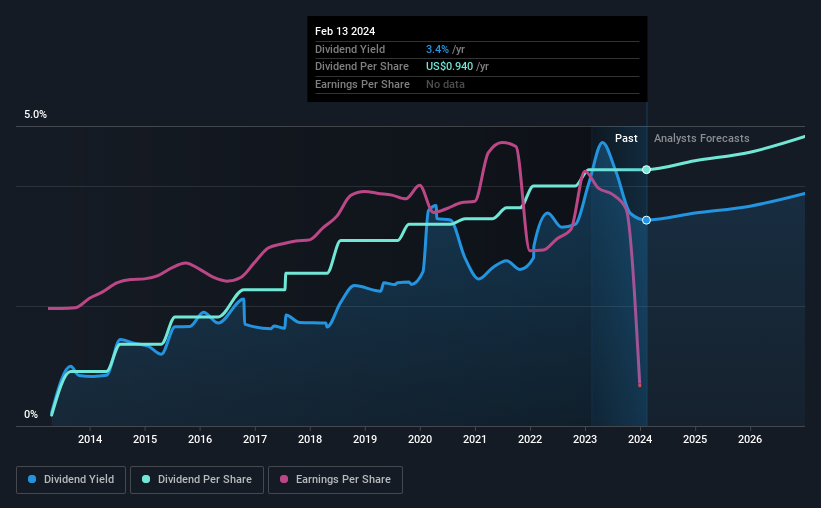- United States
- /
- Banks
- /
- NYSE:CADE
Cadence Bank (NYSE:CADE) Will Pay A Larger Dividend Than Last Year At $0.25

Cadence Bank (NYSE:CADE) will increase its dividend on the 1st of April to $0.25, which is 6.4% higher than last year's payment from the same period of $0.235. Based on this payment, the dividend yield for the company will be 3.4%, which is fairly typical for the industry.
Check out our latest analysis for Cadence Bank
Cadence Bank's Payment Expected To Have Solid Earnings Coverage
We like a dividend to be consistent over the long term, so checking whether it is sustainable is important.
Cadence Bank has established itself as a dividend paying company with over 10 years history of distributing earnings to shareholders. But while this history shows that the company was able to sustain its dividend for a decent period of time, its most recent earnings report shows that the company did not make enough earnings to cover its dividend payout. This is an alarming sign for the sustainability of its dividends, as it may mean that Cadence Bankis pulling cash from elsewhere to keep its shareholders happy.
Looking forward, earnings per share is forecast by analysts to rise exponentially over the next 3 years. Additionally, they estimate future payout ratio will be 33% over the same time horizon, which makes us pretty comfortable with the sustainability of the dividend.

Cadence Bank Has A Solid Track Record
The company has a sustained record of paying dividends with very little fluctuation. Since 2014, the dividend has gone from $0.04 total annually to $0.94. This works out to be a compound annual growth rate (CAGR) of approximately 37% a year over that time. Rapidly growing dividends for a long time is a very valuable feature for an income stock.
Dividend Growth Is Doubtful
The company's investors will be pleased to have been receiving dividend income for some time. However, initial appearances might be deceiving. It's not great to see that Cadence Bank's earnings per share has fallen at approximately 6.9% per year over the past five years. A modest decline in earnings isn't great, and it makes it quite unlikely that the dividend will grow in the future unless that trend can be reversed. Earnings are predicted to grow over the next year, but we would remain cautious until a track record of earnings growth is established.
The Dividend Could Prove To Be Unreliable
Overall, this is probably not a great income stock, even though the dividend is being raised at the moment. We can't deny that the payments have been very stable, but we are a little bit worried about the very high payout ratio. We would probably look elsewhere for an income investment.
Companies possessing a stable dividend policy will likely enjoy greater investor interest than those suffering from a more inconsistent approach. Meanwhile, despite the importance of dividend payments, they are not the only factors our readers should know when assessing a company. Taking the debate a bit further, we've identified 1 warning sign for Cadence Bank that investors need to be conscious of moving forward. If you are a dividend investor, you might also want to look at our curated list of high yield dividend stocks.
New: AI Stock Screener & Alerts
Our new AI Stock Screener scans the market every day to uncover opportunities.
• Dividend Powerhouses (3%+ Yield)
• Undervalued Small Caps with Insider Buying
• High growth Tech and AI Companies
Or build your own from over 50 metrics.
Have feedback on this article? Concerned about the content? Get in touch with us directly. Alternatively, email editorial-team (at) simplywallst.com.
This article by Simply Wall St is general in nature. We provide commentary based on historical data and analyst forecasts only using an unbiased methodology and our articles are not intended to be financial advice. It does not constitute a recommendation to buy or sell any stock, and does not take account of your objectives, or your financial situation. We aim to bring you long-term focused analysis driven by fundamental data. Note that our analysis may not factor in the latest price-sensitive company announcements or qualitative material. Simply Wall St has no position in any stocks mentioned.
About NYSE:CADE
Flawless balance sheet with reasonable growth potential and pays a dividend.


